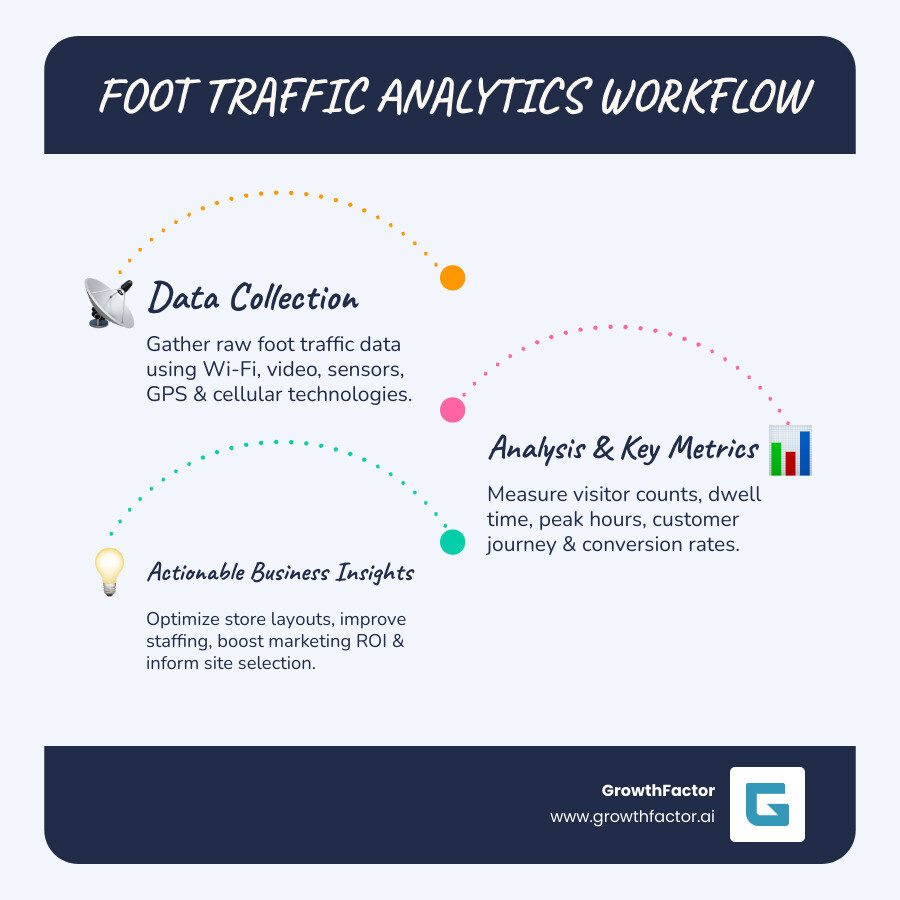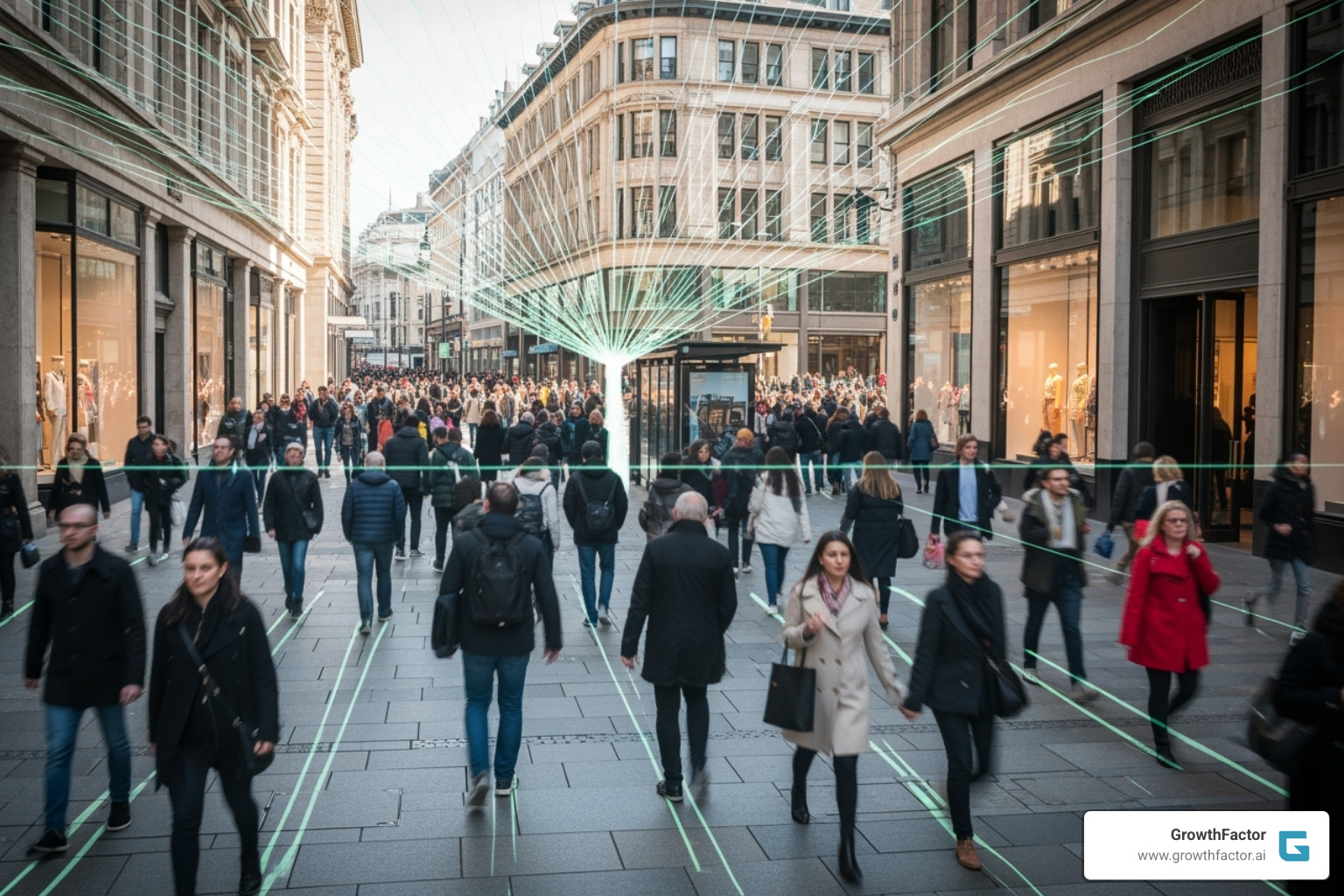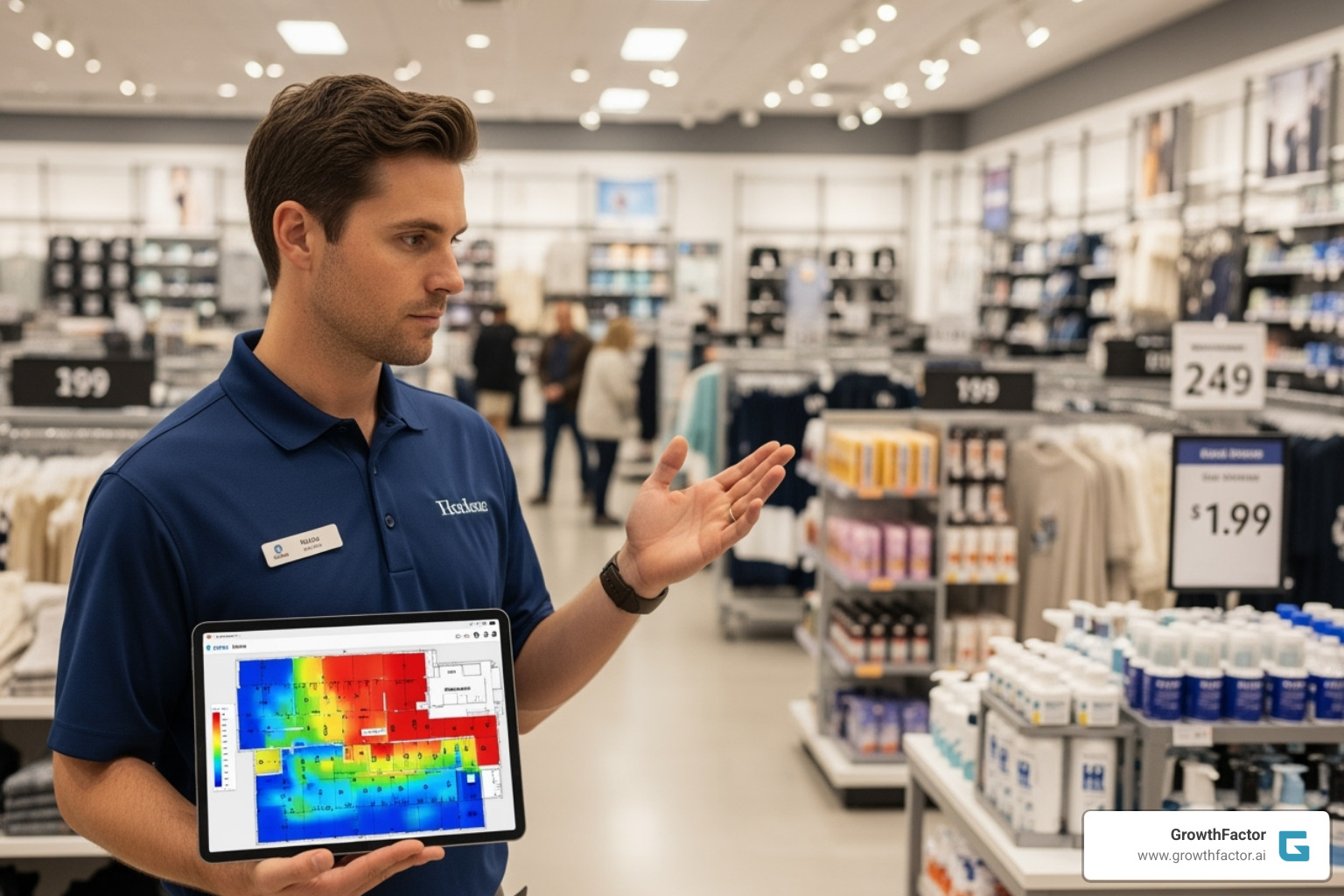Where the Sidewalk Ends, Your Data Begins: A Guide to Foot Traffic Analytics
Written by: Clyde Christian Anderson
The Unseen Data Stream of Physical Spaces
Foot traffic analytics transforms invisible customer movement into actionable business intelligence. It involves collecting and analyzing data on how people move through physical spaces like retail stores, malls, or entire commercial districts.
What foot traffic analytics measures:
- Visitor counts - Total number of people entering a location
- Dwell time - How long customers spend in specific areas
- Peak hours - Busiest times of day, week, or season
- Customer journey mapping - Paths people take through spaces
- Conversion rates - Percentage of visitors who make purchases
- Cross-visitation patterns - How customers move between locations
This data gives brick-and-mortar businesses the same level of behavioral insight that online retailers have long enjoyed. Businesses that leverage foot traffic analytics gain a competitive edge through optimized store layouts, smarter staffing, and more effective marketing. They can identify underperforming areas, benchmark against competitors, and make data-driven decisions on everything from product placement to site selection.
The global foot traffic analytics market is growing significantly, driven by the adoption of IoT devices and big data analytics. Retailers using these insights can reduce labor costs by staffing according to traffic, measure marketing ROI by tracking visitor changes, and serve customers better through a deeper understanding of their behavior.
I'm Clyde Christian Anderson, Founder and CEO of GrowthFactor.ai. We've used advanced analytics, including foot traffic data, to process over 2,000 potential retail locations, helping retailers make smarter expansion decisions. My experience ranges from retail operations to building AI platforms that integrate foot traffic analytics with site selection intelligence.

Foot traffic analytics terms at a glance:
The "How" and "What" of Foot Traffic Analytics

Without foot traffic analytics, physical businesses can't decode the intricate patterns of human behavior within their space. It's not just about counting visitors; it's about creating a detailed map of customer behavior that reveals hidden opportunities.
Methods for Measuring Physical World Activity
The magic of foot traffic analytics comes from various technologies that capture movement data. Combining several approaches often yields the richest insights.
Wi-Fi tracking detects signals from customers' mobile devices. Sensors pick up these unique, anonymized signals to map movement patterns, dwell time, and return visits.
GPS data is ideal for outdoor spaces, using anonymized location data from mobile apps to understand broader movement patterns, such as how people travel between points of interest.
Bluetooth guides (guides) offer precise indoor positioning. These small devices broadcast signals that smartphone apps detect, making them perfect for tracking movement through specific store sections.
Video analytics uses AI-powered cameras to analyze video feeds. It can count people, map customer paths, measure dwell time near displays, and detect queue lengths, distinguishing between staff and customers for cleaner data.
Thermal sensors provide a privacy-friendly alternative by detecting body heat. They excel at counting people at entrances or bottlenecks, working well in any lighting condition while ensuring anonymity.
Cellular data from mobile carriers offers a macro view of population density and movement across large areas like cities, which is invaluable for urban planning and site selection.
Smart sensors with AI integration use infrared or lidar for highly accurate pedestrian counting at entry points. AI improves them to track direction and estimate basic demographics.
Key Metrics Derived from Foot Traffic Analytics
Raw data becomes powerful when transformed into metrics that tell the story of customer behavior.
Visitor counts are the foundation, tracking the total number of people entering a location. This establishes the potential customer base for further analysis.
Dwell time measures how long customers stay in specific areas. High dwell time often signals strong engagement, while low dwell time can indicate a lack of interest.
Peak hours identification reveals your busiest periods, which is crucial for optimizing staffing, merchandising, and marketing. Analyzing this data helps retailers staff accordingly, reducing labor costs.
Bounce rate measures visitors who enter but leave quickly without engaging. A high bounce rate at an entrance may indicate uninviting displays.
Customer journey mapping visualizes the paths people take through your space, revealing traffic flow, bottlenecks, and bypassed areas.
Conversion rates, calculated by integrating with point-of-sale systems, show the percentage of visitors who make a purchase, directly measuring sales floor effectiveness.
High foot traffic analysis focuses on areas with heavy visitor volume, helping replicate success or position promotions for maximum impact.
Cross-visitation analysis examines customer movement between different locations, revealing insights about loyalty and beneficial business adjacencies.
Understanding Customer Behavior and Preferences
The real power emerges when you understand the motivations behind customer movements.
Identifying popular zones uses dwell time and pathing data to pinpoint a space's most attractive areas, helping to optimize the entire layout.
Analyzing pathing data reveals customer flow patterns, guiding decisions on product placement and signage.
Visitor segmentation allows for anonymous categorization based on behavior, such as distinguishing "browsers" from "mission shoppers" to enable custom strategies.
Sales data integration overlays traffic patterns with sales information to see if high-traffic areas generate revenue, answering critical ROI questions.
Personalizing in-store experiences becomes possible when traffic insights inform personalization. For example, sending targeted promotions to loyalty members who frequent a specific section.
Data-driven site selection is a key application. At GrowthFactor, our AI Agent Waldo uses foot traffic patterns and customer behavior data to help evaluate five times more sites efficiently, automating qualification to find locations with the right traffic for success.
Applying Insights and Navigating the Future

The real magic of foot traffic analytics happens when insights are transformed into concrete actions that drive business growth and improve customer experiences.
Practical Applications Across Industries
The versatility of foot traffic analytics allows it to revolutionize operations across various sectors.
- Retail store layout optimization: Place high-margin products in high-traffic zones to boost sales. Understanding customer behavior helps optimize the entire store layout.
- Staffing schedule adjustments: Use data to identify peak hours and lulls, allowing for precise staff scheduling that meets demand and reduces labor costs.
- Marketing campaign effectiveness: Measure foot traffic changes before and after a campaign to get concrete proof of its ROI.
- Real estate site selection: Location intelligence platforms with foot traffic data help businesses make data-driven expansion decisions. Our AI Agent Waldo processes this data across thousands of sites, helping teams evaluate locations more efficiently.
- Urban planning: Planners can design better public spaces and optimize traffic flow based on real human movement patterns.
- Hospitality guest flow: Hotels, restaurants, and venues can eliminate bottlenecks and optimize layouts to guide guests smoothly.
- Retail site location analysis: Benchmark store performance against competitors and analyze entire markets to find the best locations for specific brands.
Challenges and Privacy Best Practices
Implementing foot traffic analytics comes with challenges that require careful navigation.
- Data accuracy issues: Environmental factors and sensor placement can affect readings. Understand these limitations and calibrate systems for actionable, if not perfect, data.
- Implementation costs: While there are initial costs for hardware and software, the long-term ROI from optimized operations and increased sales typically outweighs them.
- Data security: Robust cybersecurity is essential to protect collected data and maintain customer trust.
- GDPR and CCPA compliance: Adherence to regulations like the General Data Protection Regulation (GDPR) is non-negotiable. These rules mandate transparency and data minimization, which also leads to better analytics.
- Anonymization techniques: Always anonymize data by hashing MAC addresses and focusing on aggregate movement patterns, not individuals.
- Transparency with customers: Simple signage explaining that you collect anonymous data to improve their experience builds trust.
- Data integration challenges: Combining foot traffic data with sales, marketing, and other systems requires careful planning, highlighting the value of integrated platforms.
The Future of Foot Traffic Analytics
The future of foot traffic analytics is being shaped by AI, IoT, and privacy-conscious design.
AI and machine learning integration is turning raw data into predictive intelligence, spotting subtle patterns that human analysts might miss.
Predictive analytics is the next leap, allowing businesses to forecast staffing needs or predict the impact of product placement, enabling proactive operations.
IoT device growth is creating richer datasets from sources like smart carts and connected displays, contributing to a more complete picture of customer behavior.
Hyper-personalization is becoming possible while respecting privacy, with dynamic signage or app notifications based on observed crowd behavior.
Combining online and offline data is the holy grail for understanding the complete customer journey, from online research to in-store purchase.
At GrowthFactor, we are pioneering this integration for retail real estate. Our AI-powered platform synthesizes foot traffic analytics with dozens of other data points for site selection and deal tracking. Our AI Agent Waldo exemplifies this future, automating evaluation processes to help retail teams make faster, smarter decisions.
The sidewalk may end where your store begins, but with foot traffic analytics, your understanding of customer behavior is just getting started. To explore how these insights can transform your business, find our all-in-one real estate platform and find what's possible when data meets strategy.
Citations
The human algorithm
Request Your demo
Schedule meeting
Or submit your information below and we'll be in touch to schedule.



